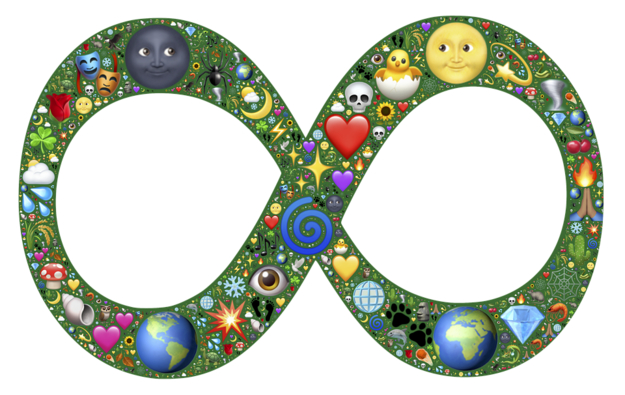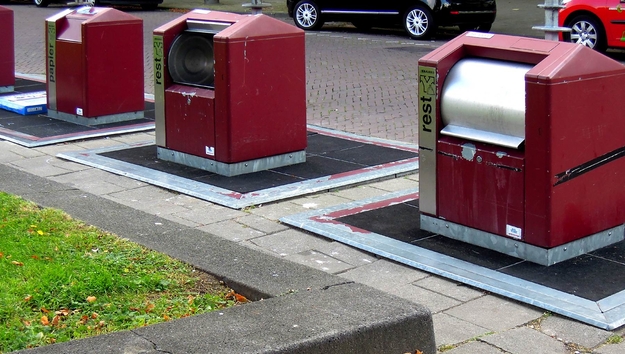Waste
As a verb: "use or expend carelessly, extravagantly, or to no purpose."
Noun and adjective: "(of a material, substance, or by-product) eliminated or discarded as no longer useful or required after the completion of a process." (Oxford Dictionary)
In both definitions, the common denominator seems to be human subjectivity, hindered by its own sets of limitations of what is useful, and what isn't.
Nature never wastes. Only Humans do.
Can we find examples of waste in Nature? How about the fallen leaves from trees in the autumn, or even biological excretions? In examining the former, we can visualise the process of fresh, green tree leaves turning brown and dry in the fall covering the soil. Those leaves are an important source of carbon, which is then slowly processed by a diverse ecosystem made of animals and micro-organisms living in the soil, ultimately re-distributing valuable nutrients back into the soil, giving the tree the food (energy) it needs to grow for the next cycle. As for biological excretions (poo), we also know that those are potent natural fertilisers used commonly in the industry for growing plants.
And waste, we do. According to the latest data available from the WorldBank (2016), more than 2 billion tonnes of solid waste was produced across the World's cities. What's more alarming is the forecast predicting a 70% increase by 2050.
Another frightening statistic is that one-third of all the food produced and consumed is discarded or wasted altogether (Food and Agriculture Organization, UN).
This has huge ramifications in the context of poverty (food insecurity; lack of proper waste-treatment infrastructures), climate change (greenhouse gases from rotting waste), as well as declining health and economies. In short, we are all onboard a sinking Titanic realising our more-than-likely demise.
However, crises offer us new opportunities. In fact, many of the solutions to these problems already exist in various communities around the world. If only we can bring some of those solutions to light, maybe, we can pivot our way out of this crisis and fix our mistakes.
My goal as a waste-management intern at Mediamatic is to experiment and implement some of these solutions, focusing on organic/bio-waste, and to provide an educational experience to teach about the value of the waste we produce.
Highlights: Amsterdam, Netherlands
- Population: 821,752 (2015) / 1.1 million greater urban area (2015, CIA World Factbook)
- 406 kg/per capita of waste generated every year on average (Municipal Waste Europe, 2013)
- Collected waste in 2013 sorted by categories: paper/cardboard (44%), glass (35%), plastics (2%), bio-waste (1%) and hazardous waste (18%)
- Only one district (Nieuw-West) currently provides bio-waste disposal services.
- Total annual waste-management costs paid with citizen-tax: 100 Million Euro
Case-study: Mediamatic
Available waste-streams: office (cardboard, paper, plastics, miscellaneous); restaurant (organic waste, cardboard, cans); garden (yard waste; organic materials)
Solution #1: Compost
Compost is the easiest way to dispose of organic and yard wastes. Mediamatic has implemented two kinds of compost: A general one for yard clippings and general organic waste. And an experimental bokashi compost, using anaerobic fermentation to compost food-scraps exclusively.
Expected goal: Diverting organic waste from landfills, while creating nutrient-rich humus for the gardens to grow food and flowers. Extras, if available could also be provided to community members.
State: In progress.
Solution #2: Bio-Char
Bio-char is basically charcoal produced in a low-oxygen environment (pyrolysis) using woody materials (tree waste, such as branches). Biochar is a highly beneficial amendment that has a multitude of cascading uses, from being used for water filtration and then as fertiliser, to the creation of new polymers in the construction industry (mixed with concrete); as a health supplement for indigestion troubles, to food for animals. Biochar can be made with very simple, low-cost DIY setups using already available material. Here is compiled list of 55-uses from the Biochar-Journal for more information.
Expected goal: use wood materials from our yard waste to improve soil condition, and potentially create water-filtration applications.
State: already being used in the gardens. Although no formal production plans yet.
Solution #3: Insect-farming
Insect-farming, in particular Black Soldier Fly (Hermetia Illucens), can provide very productive bio-waste conversion into rich protein filled larvae for animal feed (and even human) consumption. They only require adequate food, water and ideal temperatures (25ºC~30ºC). Dubbed as the next viable protein of the future, a small-scale farming of BSF could provide, at least partially, nutritious feed for the fish in our Aquaponics system.
The benefits of this are a low-cost, low-maintenance setup that can reliably process food waste.
State: Conceptual.
With readily available resources on-site, there are plenty of opportunities to experiment and implement some of these ideas, and most importantly, to provide an educational space to bring light to these novel solutions. There are many more ideas that could be implemented, and it is an exciting prospect to think about.

